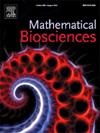Optimal control of eggplant pest populations in a Predator–Prey–Parasitoid model with seasonal growth effects
IF 1.8
4区 数学
Q2 BIOLOGY
引用次数: 0
Abstract
This study investigates the population dynamics of the eggplant fruit and shoot borer (EFSB), emphasizing the role of natural enemies — predators and parasitoids — in pest management. A mathematical model, comprising three variables representing each population, is constructed to analyze the interactions. The model exhibits six equilibrium points, with particular focus on the predator-free and coexistence equilibria. Crucially, the model incorporates the seasonal variability of the pest’s growth rate, reflecting the influence of environmental factors such as temperature changes. Optimal control strategies are explored, encompassing both chemical and biological approaches, including the use of parasitoids. For chemical control, Pontryagin’s Minimum Principle is employed to derive optimal strategies under varying seasonal growth conditions. The biological control strategy, centered on parasitoid release, is analyzed using State-Dependent Riccati Equations (SDRE) to determine optimal continuous and impulsive release methods. The findings highlight the importance of considering seasonal variations in pest growth and demonstrate the efficacy of impulsive parasitoid releases for pest management. This research provides valuable insights into sustainable pest management and offers a robust framework for applying mathematical modeling to complex agricultural systems.
具有季节生长效应的捕食者-被食性-寄生性模型对茄子害虫种群的最优控制
本文研究了茄子果笋螟(EFSB)的种群动态,强调天敌和寄生蜂在茄子果笋螟防治中的作用。建立了一个数学模型,其中包含代表每个种群的三个变量,以分析相互作用。该模型具有6个平衡点,特别关注无捕食者平衡点和共存平衡点。至关重要的是,该模型纳入了害虫生长速度的季节性变化,反映了温度变化等环境因素的影响。探索了最优控制策略,包括化学和生物方法,包括使用拟寄生虫。在化学防治方面,采用庞特里亚金最小值原理推导出不同季节生长条件下的最优策略。以寄生虫释放为中心,利用状态相关Riccati方程(SDRE)对生物防治策略进行了分析,确定了最优的连续和脉冲释放方法。这些发现强调了考虑害虫生长季节变化的重要性,并证明了脉冲释放寄生蜂对害虫管理的有效性。这项研究为可持续虫害管理提供了有价值的见解,并为将数学建模应用于复杂的农业系统提供了一个强大的框架。
本文章由计算机程序翻译,如有差异,请以英文原文为准。
求助全文
约1分钟内获得全文
求助全文
来源期刊

Mathematical Biosciences
生物-生物学
CiteScore
7.50
自引率
2.30%
发文量
67
审稿时长
18 days
期刊介绍:
Mathematical Biosciences publishes work providing new concepts or new understanding of biological systems using mathematical models, or methodological articles likely to find application to multiple biological systems. Papers are expected to present a major research finding of broad significance for the biological sciences, or mathematical biology. Mathematical Biosciences welcomes original research articles, letters, reviews and perspectives.
 求助内容:
求助内容: 应助结果提醒方式:
应助结果提醒方式:


